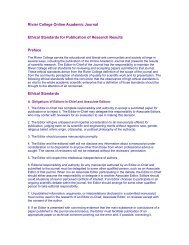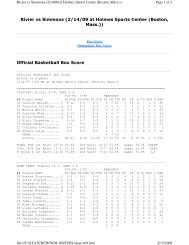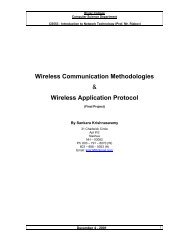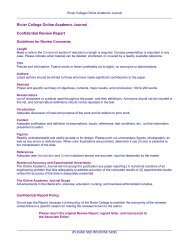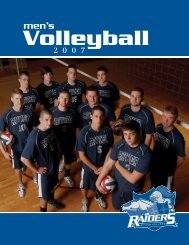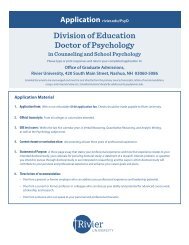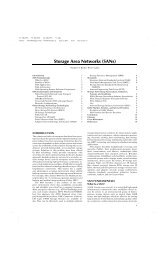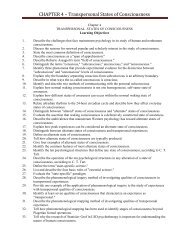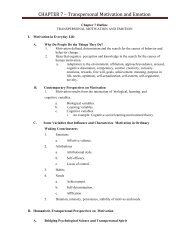Development of laboratory exercises based on ... - Rivier University
Development of laboratory exercises based on ... - Rivier University
Development of laboratory exercises based on ... - Rivier University
You also want an ePaper? Increase the reach of your titles
YUMPU automatically turns print PDFs into web optimized ePapers that Google loves.
RIVIER COLLEGE ONLINE ACADEMIC JOURNAL, VOLUME 1, NUMBER 1, FALL 2005<br />
DEVELOPMENT OF LABORATORY EXERCISES BASED ON THE<br />
OPNET NETWORK SIMULATING APPROACH<br />
Ajay Kumar*<br />
Graduate student, M.S. in Computer Science Program, <strong>Rivier</strong> College<br />
Keywords: OPNET IT Guru s<str<strong>on</strong>g>of</str<strong>on</strong>g>tware, Networking lab, Ethernet, CSMA-CD, LAN<br />
Abstract<br />
The primary purpose <str<strong>on</strong>g>of</str<strong>on</strong>g> this article is to discuss the <str<strong>on</strong>g>laboratory</str<strong>on</strong>g> <str<strong>on</strong>g>exercises</str<strong>on</strong>g> designed for using in the<br />
network-technology courses at <strong>Rivier</strong> College and analyze the lab results for the real-time networks and<br />
protocols. The labs have been developed in OPNET IT Guru Academic simulati<strong>on</strong> envir<strong>on</strong>ment,<br />
which is a network simulator that <str<strong>on</strong>g>of</str<strong>on</strong>g>fers the tools for model design, simulati<strong>on</strong>, and analysis.<br />
1 Introducti<strong>on</strong><br />
Different priorities and obstacles do not allow a small college to <str<strong>on</strong>g>of</str<strong>on</strong>g>fer a variety <str<strong>on</strong>g>of</str<strong>on</strong>g> networks to its<br />
students and faculty for using them in the classrooms. As an opti<strong>on</strong>, they can use an invaluable tool, the<br />
OPNET IT Guru Academic s<str<strong>on</strong>g>of</str<strong>on</strong>g>tware package [1] that <str<strong>on</strong>g>of</str<strong>on</strong>g>fers all the tools for network model design,<br />
simulati<strong>on</strong> and analysis at a reas<strong>on</strong>able cost. OPNET s<str<strong>on</strong>g>of</str<strong>on</strong>g>tware can simulate a wide variety <str<strong>on</strong>g>of</str<strong>on</strong>g> different<br />
networks, which are linked to each other. One can just work from his/her PC to simulate different<br />
networks and study visually the impact <str<strong>on</strong>g>of</str<strong>on</strong>g> various factors (e.g., traffic load, bandwidth, data rate, etc.) <strong>on</strong><br />
the network. With OPNET IT Guru, a sophisticated tool that provides analysis and modeling <str<strong>on</strong>g>of</str<strong>on</strong>g><br />
network performance [2], users can study data message flows, packet losses, link failures, bits errors,<br />
etc. OPNET s<str<strong>on</strong>g>of</str<strong>on</strong>g>tware is very user-friendly and easy to install.<br />
The IT Guru's installati<strong>on</strong> is straightforward and takes less than 15 minutes. The package has helpful<br />
documentati<strong>on</strong> that is well laid out, easy to use, and includes a large number <str<strong>on</strong>g>of</str<strong>on</strong>g> examples and tutorials.<br />
In additi<strong>on</strong>, the product is feature-rich and c<strong>on</strong>tains a steep learning curve. A network technician could<br />
find the product very useful in evaluating the effects <str<strong>on</strong>g>of</str<strong>on</strong>g> new applicati<strong>on</strong>s and network changes without<br />
harming the producti<strong>on</strong> network.<br />
2 Purpose<br />
The purpose <str<strong>on</strong>g>of</str<strong>on</strong>g> this article is to discuss two <str<strong>on</strong>g>laboratory</str<strong>on</strong>g> <str<strong>on</strong>g>exercises</str<strong>on</strong>g> designed for using the OPNET IT<br />
Guru Academic s<str<strong>on</strong>g>of</str<strong>on</strong>g>tware package (versi<strong>on</strong> 9.1). The following simulati<strong>on</strong> cases will be discussed:<br />
• Lab1: Ethernet (Aloha, CSMA-CD)<br />
• Lab2: Switched Local Area Network (LAN).<br />
Copyright © 2005 by Ajay Kumar. Published by <strong>Rivier</strong> College, with permissi<strong>on</strong>. 1
Ajay Kumar<br />
3 Laboratory 1: Ethernet: A Direct Link Network with Media Access C<strong>on</strong>trol<br />
3.1 Objective<br />
This lab has been designed to dem<strong>on</strong>strate the operati<strong>on</strong> <str<strong>on</strong>g>of</str<strong>on</strong>g> the Ethernet network. The simulati<strong>on</strong> in this<br />
lab will help examine the performance <str<strong>on</strong>g>of</str<strong>on</strong>g> the Ethernet network under different scenarios.<br />
3.2 Lab Overview<br />
The Ethernet is a working example <str<strong>on</strong>g>of</str<strong>on</strong>g> the more general Carrier Sense, Multiple Access with Collisi<strong>on</strong><br />
Detect (CSMS/CD) local area network technology [3]. The Ethernet is a multiple-access network,<br />
meaning that a set <str<strong>on</strong>g>of</str<strong>on</strong>g> nodes sends and receives frames over a shared link. The “carrier sense” in<br />
CSMA/CD means that all the nodes can distinguish between an idle and a busy link. The “collisi<strong>on</strong><br />
detect” means that a node listens as it transmit and can therefore detect when a frame it is transmitting<br />
has collided with a frame transmitted by another node [4].<br />
In this lab we set up an Ethernet with 14 nodes c<strong>on</strong>nected via coaxial link in a bus topology. The<br />
coaxial link is operating at a data rate <str<strong>on</strong>g>of</str<strong>on</strong>g> 10Mbps. lab is designed to explain how the throughput <str<strong>on</strong>g>of</str<strong>on</strong>g> the<br />
network is affected by the network load, as well as by the size <str<strong>on</strong>g>of</str<strong>on</strong>g> the packets.<br />
3.3 Study <str<strong>on</strong>g>of</str<strong>on</strong>g> Traffic Characteristics<br />
The simulati<strong>on</strong> results are shown in Fig. 1. We have found n<strong>on</strong>-m<strong>on</strong>ot<strong>on</strong>ous relati<strong>on</strong>ship between the<br />
received (throughput) and sent (load) packets.<br />
.<br />
Fig. 1. Traffic received (throughput) vs. Traffic sent (load).<br />
Initially throughput increases with <str<strong>on</strong>g>of</str<strong>on</strong>g>fered load and reaches a maximum value. After the maximum load<br />
is reached, any further load <strong>on</strong>ly leads to decrease in the throughput. Therefore, in order to maximize the<br />
throughput in the network, the load must be chosen carefully. The fact is that, as the traffic <strong>on</strong> the<br />
network increases, more collisi<strong>on</strong>s occur causing retransmissi<strong>on</strong> <str<strong>on</strong>g>of</str<strong>on</strong>g> frames and c<strong>on</strong>sequently increasing<br />
their overall delay.<br />
Copyright © 2005 by Ajay Kumar. Published by <strong>Rivier</strong> College, with permissi<strong>on</strong>. 2
LABS BASED ON THE OPNET NETWORK SIMULATING APPROACH<br />
Increasing the number <str<strong>on</strong>g>of</str<strong>on</strong>g> packets (load) in the network also increases the length <str<strong>on</strong>g>of</str<strong>on</strong>g> the queues at each<br />
router. L<strong>on</strong>ger queues, in turn, mean packets are delayed l<strong>on</strong>ger in the network, and, hence, the traffic<br />
received is dropped. At the same time too c<strong>on</strong>servative approach leads to the drop again as it does not<br />
allow enough packets to being sent to keep the links busy.<br />
In the Ethernet, collisi<strong>on</strong>s increase as the network is loaded, and this causes retransmissi<strong>on</strong>s and<br />
increases in load that cause even more collisi<strong>on</strong>s. The resulting network overload slows traffic<br />
c<strong>on</strong>siderably.<br />
3.4 Analysis <str<strong>on</strong>g>of</str<strong>on</strong>g> Traffic Received<br />
We have studied three variati<strong>on</strong>s <str<strong>on</strong>g>of</str<strong>on</strong>g> the previous simulati<strong>on</strong> scenario: the coax_Q2a, coax_Q2b and<br />
coax_Q2c cases, for which the inter-arrival time attribute <str<strong>on</strong>g>of</str<strong>on</strong>g> the packet generati<strong>on</strong> arguments has been<br />
set to the exp<strong>on</strong>ential factors <str<strong>on</strong>g>of</str<strong>on</strong>g> 0.1, 0.05, and 0.025, respectively.<br />
Fig. 2. Throughput Traffic Received vs. Inter-Arrival Time<br />
The results <str<strong>on</strong>g>of</str<strong>on</strong>g> simulati<strong>on</strong>s are shown in Figure 2. We found that with decreasing the inter-arrival<br />
time the throughput (traffic received) increases till a certain maximum throughput is reached, and then<br />
decreases.<br />
The Figure 3 shows the collisi<strong>on</strong> dynamics in the network, which is characterized by the average<br />
number <str<strong>on</strong>g>of</str<strong>on</strong>g> collisi<strong>on</strong>s. We found that, as l<strong>on</strong>g as the inter-arrival time is within a given limited range, the<br />
number <str<strong>on</strong>g>of</str<strong>on</strong>g> collisi<strong>on</strong>s remains small. Once the critical threshold is reached, the number <str<strong>on</strong>g>of</str<strong>on</strong>g> collisi<strong>on</strong>s<br />
increases dramatically.<br />
Copyright © 2005 by Ajay Kumar. Published by <strong>Rivier</strong> College, with permissi<strong>on</strong>. 3
Ajay Kumar<br />
3.5 Ethernet Scale vs. Its Performance<br />
Fig. 3. Average Number <str<strong>on</strong>g>of</str<strong>on</strong>g> Collisi<strong>on</strong>s<br />
In this secti<strong>on</strong>, we study the effect <str<strong>on</strong>g>of</str<strong>on</strong>g> the number <str<strong>on</strong>g>of</str<strong>on</strong>g> stati<strong>on</strong>s <strong>on</strong> the Ethernet performance. The number<br />
<str<strong>on</strong>g>of</str<strong>on</strong>g> stati<strong>on</strong>s has been reduced from 30 (the original case, coax_Q2c) to 15 nodes (a new case, coax_Q3).<br />
The comparis<strong>on</strong> <str<strong>on</strong>g>of</str<strong>on</strong>g> the node collisi<strong>on</strong> counts in these scenarios indicates that, as the number <str<strong>on</strong>g>of</str<strong>on</strong>g> nodes in<br />
the network increases, the number <str<strong>on</strong>g>of</str<strong>on</strong>g> collisi<strong>on</strong>s increases (see Fig. 4).<br />
Fig. 4. Collisi<strong>on</strong> for a 15 node vs. 30 node cases<br />
Copyright © 2005 by Ajay Kumar. Published by <strong>Rivier</strong> College, with permissi<strong>on</strong>. 4
LABS BASED ON THE OPNET NETWORK SIMULATING APPROACH<br />
3.6 Packet Size Effects<br />
We have studied the effect <str<strong>on</strong>g>of</str<strong>on</strong>g> the packet size <strong>on</strong> the throughput <str<strong>on</strong>g>of</str<strong>on</strong>g> the Ethernet network. The results<br />
shown in Figures 5 and 6 indicate that the throughput (traffic received) for the 512 byte packet (the<br />
coax_Q4 case) is greater than that <strong>on</strong>e for the 1024 byte packets (the coax_Q2c case), although the bit<br />
rates are significantly different in both cases.<br />
Fig. 5. Traffic Received (packets per sec)<br />
Fig. 6. Traffic Received (bits per sec)<br />
Copyright © 2005 by Ajay Kumar. Published by <strong>Rivier</strong> College, with permissi<strong>on</strong>. 5
Ajay Kumar<br />
4 Laboratory 2: A Set <str<strong>on</strong>g>of</str<strong>on</strong>g> Local Area Networks Interc<strong>on</strong>nected by Switches<br />
4.1 Objective<br />
This lab has been designed to dem<strong>on</strong>strate the implementati<strong>on</strong> <str<strong>on</strong>g>of</str<strong>on</strong>g> switched local area networks. The<br />
simulati<strong>on</strong> in this lab will help examine the performance <str<strong>on</strong>g>of</str<strong>on</strong>g> different implementati<strong>on</strong>s <str<strong>on</strong>g>of</str<strong>on</strong>g> local area<br />
networks c<strong>on</strong>nected by switches and hubs.<br />
4.2 Lab Overview<br />
There is a limit <strong>on</strong> the number <str<strong>on</strong>g>of</str<strong>on</strong>g> hosts that can be attached to a single network and <strong>on</strong> the size <str<strong>on</strong>g>of</str<strong>on</strong>g> a<br />
geographic area that a single network can serve [3, 4]. Computer networks use switches to enable the<br />
communicati<strong>on</strong> between <strong>on</strong>e host and another, even when no direct c<strong>on</strong>necti<strong>on</strong> exists between those<br />
hosts [3].<br />
The key problem that a switch must deal with is the finite bandwidth <str<strong>on</strong>g>of</str<strong>on</strong>g> its outputs [4]. If packets<br />
destined for a certain output arrive at a switch and their arrival rate exceeds the capacity <str<strong>on</strong>g>of</str<strong>on</strong>g> that output,<br />
then we have a problem <str<strong>on</strong>g>of</str<strong>on</strong>g> c<strong>on</strong>necti<strong>on</strong>. In this case, the switch will queue (or buffer) packets until the<br />
c<strong>on</strong>tenti<strong>on</strong> subsides. If it lasts too l<strong>on</strong>g, however, the switch will run out <str<strong>on</strong>g>of</str<strong>on</strong>g> buffer space and be forced to<br />
discard the packets. When packets are discarded too frequently, the switch is said to be c<strong>on</strong>gested [3].<br />
4.3 The Switch Role<br />
The following study dem<strong>on</strong>strates why the adding <str<strong>on</strong>g>of</str<strong>on</strong>g> a switch makes a network perform better in terms<br />
<str<strong>on</strong>g>of</str<strong>on</strong>g> throughput and delay characteristics.<br />
Fig. 7. Traffic Received (Throughput) for the Hub and Hub-and-Switch Cases.<br />
Copyright © 2005 by Ajay Kumar. Published by <strong>Rivier</strong> College, with permissi<strong>on</strong>. 6
LABS BASED ON THE OPNET NETWORK SIMULATING APPROACH<br />
Fig. 8. Traffic Sent (Load) for the Hub and Hub-and-Switch Cases.<br />
We have studied two cases: 1) Ethernet with the hub <strong>on</strong>ly, and 2) Ethernet with the hub and switch. The<br />
results shown in Figures 7 and 8 dem<strong>on</strong>strate that, although the traffic send is almost the same in both<br />
cases, the traffic received has improved in the Hub-and-Switch case. The sec<strong>on</strong>d c<strong>on</strong>figurati<strong>on</strong> makes<br />
network perform better in terms <str<strong>on</strong>g>of</str<strong>on</strong>g> throughput and delay characteristics.<br />
With a switched network any user can be c<strong>on</strong>nected to each port directly [3]. Therefore, the<br />
bandwidth is shared <strong>on</strong>ly am<strong>on</strong>g a number <str<strong>on</strong>g>of</str<strong>on</strong>g> users in the workgroup (c<strong>on</strong>nected to the ports). Since this<br />
is the reduced media, the sharing <str<strong>on</strong>g>of</str<strong>on</strong>g> other porti<strong>on</strong>s <str<strong>on</strong>g>of</str<strong>on</strong>g> the bandwidth is available. Switches can also<br />
maintain multiple c<strong>on</strong>necti<strong>on</strong>s at <strong>on</strong>e point [3, 4].<br />
Switches normally have higher port counts than bridges and divide network into several dedicated<br />
channels independent (“parallel”) from each other. These multiple independent data paths increase the<br />
throughput capacity <str<strong>on</strong>g>of</str<strong>on</strong>g> a switch. There is no c<strong>on</strong>tenti<strong>on</strong> to gain access, and LAN switch architecture<br />
becomes scalable. Another advantage <str<strong>on</strong>g>of</str<strong>on</strong>g> switches is that most <str<strong>on</strong>g>of</str<strong>on</strong>g> them are self-c<strong>on</strong>figuring. This<br />
property allows to minimizing the network downtime, although ways for manual c<strong>on</strong>figurati<strong>on</strong> are also<br />
available [4].<br />
4.4 Analysis <str<strong>on</strong>g>of</str<strong>on</strong>g> the Collisi<strong>on</strong> in the Switched LAN<br />
The use <str<strong>on</strong>g>of</str<strong>on</strong>g> the switch makes it possible to reduce the collisi<strong>on</strong>s <strong>on</strong> the network. The communicati<strong>on</strong><br />
procedures follow the certain rules. For example, when a peripheral device wishes to communicate, it<br />
sends the request for communicati<strong>on</strong> (a “message”) that reaches the switch. If another peripheral device<br />
communicates already, two messages are found at the same time <strong>on</strong> the network. The message from the<br />
first host is taken at the beginning <str<strong>on</strong>g>of</str<strong>on</strong>g> a queue, and the sec<strong>on</strong>d host waits for trying again to communicate<br />
a few millisec<strong>on</strong>ds later.<br />
Switches up<strong>on</strong> finding that the destinati<strong>on</strong> port is overloaded will send the jam message to the<br />
sender. Since the decoding <str<strong>on</strong>g>of</str<strong>on</strong>g> the MAC address is fast and the switch can, in very little time, resp<strong>on</strong>d<br />
with a jam message, collisi<strong>on</strong> or packet loss can be avoided [3, 4].<br />
Copyright © 2005 by Ajay Kumar. Published by <strong>Rivier</strong> College, with permissi<strong>on</strong>. 7
Ajay Kumar<br />
Fig. 9. Collisi<strong>on</strong> Counts for Various Ethernet Network C<strong>on</strong>figurati<strong>on</strong>s.<br />
The data shown in Figure 9 dem<strong>on</strong>strates that the network performance improves in LANs, in which<br />
LAN switches are installed, because the LAN switch creates isolated collisi<strong>on</strong> domains. Many LAN<br />
switch installati<strong>on</strong>s assign just <strong>on</strong>e user per port [3]. By distributing users over several collisi<strong>on</strong><br />
domains, collisi<strong>on</strong>s are avoided and performance improves.<br />
4.4 Performance <str<strong>on</strong>g>of</str<strong>on</strong>g> Various Network C<strong>on</strong>figurati<strong>on</strong>s<br />
Fig. 10. Time Average in Traffic Sent<br />
Copyright © 2005 by Ajay Kumar. Published by <strong>Rivier</strong> College, with permissi<strong>on</strong>. 8
LABS BASED ON THE OPNET NETWORK SIMULATING APPROACH<br />
We have studied the network performances (in terms <str<strong>on</strong>g>of</str<strong>on</strong>g> delay throughput and collisi<strong>on</strong> count) for the<br />
following four network c<strong>on</strong>figurati<strong>on</strong>s:<br />
1) The Only-Hub case: Hubs with out any switch<br />
2) The Only-Hub1case: Hub is replaced by a switch<br />
3) The Hub-and-Switch case: Two hubs and <strong>on</strong>e switch<br />
4) The Hub-and-Switch1 case: Two switches <strong>on</strong>ly<br />
The Traffic Sent (load) parameters have been almost the same in all the cases (see Figure 10). We have<br />
found that there is a slight improvement in the network performance (Traffic Received characteristics) in<br />
all the cases with switches (see Figure 11).<br />
Fig. 11. Time Average in Traffic Received<br />
The data shown in the Figure 12 dem<strong>on</strong>strates that the delay in the cases with the switches without<br />
hubs (the Only-Hub1, Hub-and-Switch, and Hub-and-Switch1 cases) is significantly less compared<br />
to the network c<strong>on</strong>figurati<strong>on</strong>s with a hub (the Only-Hub case). Particularly, when we replaced two<br />
hubs with switches the delay is almost negligible.<br />
Copyright © 2005 by Ajay Kumar. Published by <strong>Rivier</strong> College, with permissi<strong>on</strong>. 9
Ajay Kumar<br />
5. C<strong>on</strong>clusi<strong>on</strong><br />
Fig. 12. Time Average Delay for Various Network C<strong>on</strong>figurati<strong>on</strong>s.<br />
This article c<strong>on</strong>sists <str<strong>on</strong>g>of</str<strong>on</strong>g> two <str<strong>on</strong>g>laboratory</str<strong>on</strong>g> <str<strong>on</strong>g>exercises</str<strong>on</strong>g> that cover a range <str<strong>on</strong>g>of</str<strong>on</strong>g> important topics in networking.<br />
The users are provided an opportunity to experience the behavior <str<strong>on</strong>g>of</str<strong>on</strong>g> different networks and protocols, as<br />
well as a tool for learning principles and procedures <str<strong>on</strong>g>of</str<strong>on</strong>g> network simulati<strong>on</strong> by using the OPNET IT<br />
GURU Academic Modeler simulati<strong>on</strong> envir<strong>on</strong>ment. Nowadays, this is the most cost effective soluti<strong>on</strong><br />
for colleges and universities to dem<strong>on</strong>strate the performance <str<strong>on</strong>g>of</str<strong>on</strong>g> different networks and protocols.<br />
6. Acknowledgments<br />
I would like to take this opportunity and thank the Department <str<strong>on</strong>g>of</str<strong>on</strong>g> Mathematics and Computer Science at<br />
the River College for giving me the opportunity to write an article <strong>on</strong> such interesting and challenging<br />
topic. Finally, I would like to give special thanks to Dr. Vladimir V. Riabov, Ph.D., associate pr<str<strong>on</strong>g>of</str<strong>on</strong>g>essor<br />
<str<strong>on</strong>g>of</str<strong>on</strong>g> Computer Science, for all the support and help.<br />
References<br />
[1] IT Guru Academic Editi<strong>on</strong>. OPNET Technologies, 2005. Retrieved October 1, 2005, from<br />
http://www.opnet.com/services/university/itguru_academic_editi<strong>on</strong>.html.<br />
[2] The World’s Leading Network Modeling and Simulati<strong>on</strong> Envir<strong>on</strong>ment. OPNET Technologies, 2004. Retrieved October<br />
1, 2005, from http://www.opnet.com/products/modeler/home.html.<br />
[3] William Stallings. Data and Computer Communicati<strong>on</strong>s, 7 th Editi<strong>on</strong>. Pears<strong>on</strong> Educati<strong>on</strong>, 2005.<br />
[4] Larry L. Peters<strong>on</strong> and Bruce S. Davie. Computer Networks: A System Approach, 3 rd Editi<strong>on</strong>. Morgan Kaufmann, 2005.<br />
______________________________________<br />
* AJAY KUMAR was born in Bangalore, India. He received his B.S. in Mathematics, Physics and Chemistry from<br />
Bangalore <strong>University</strong> in India in 1991. After emigrati<strong>on</strong> to the United States in 1996, he worked as a c<strong>on</strong>sultant and<br />
s<str<strong>on</strong>g>of</str<strong>on</strong>g>tware developer for Unisys Corporati<strong>on</strong>. Ajay is currently a computer programmer/analyst at TradePoint Systems in<br />
Nashua. He passed the Oracle Certified Associate exams. Ajay is pursuing a M.S. in Computer Science at <strong>Rivier</strong> College.<br />
Copyright © 2005 by Ajay Kumar. Published by <strong>Rivier</strong> College, with permissi<strong>on</strong>. 10




